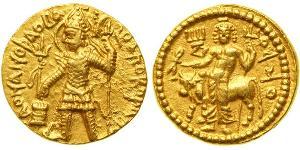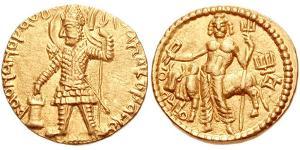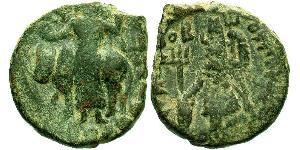| This article needs additional citations for verification. (March 2012) |
Vasudeva I (Kushan: ΒΑΖΟΔΗΟ "Bazodeo", Chinese: 波調 "Bodiao") was a Kushan emperor, last of the "Great Kushans." Named inscriptions dating from year 64 to 98 of Kanishka's era suggest his reign extended from at least 191 to 225 CE.
The last named inscription of his predecessor, Huvishka, was in the year 60 = 187 CE, and the Chinese evidence suggests he was still ruling as late as 229 CE. He was the last great Kushan emperor, and the end of his rule coincides with the invasion of the Sassanians as far as northwestern India, and the establishment of the Indo-Sassanians or Kushanshahs from around 240 CE.
His name, Vasudeva, is that of the father of Krishna, the popular Hindu god, and he was the first Kushan king to be named after an Indian god. He converted to Hinduism during his reign.[1][dead link][dubious ]
Contacts with China[edit]
In the Chinese historical chronicle Sanguozhi (三國志), he is recorded to have sent tribute to the Chinese emperor Cao Rui of the Wei in 229 CE (3rd year of Taihe 太和), :
- "The king of the Da Yuezhi, Bodiao (波調) (Vāsudeva), sent his envoy to present tribute and His Majesty granted him a title of "King of the Da Yuezhi Intimate with Wei (魏)"." ( Sanguozhi)
He is the last Kushan ruler to be mentioned in Chinese sources. His rule corresponds to the retreat of Chinese power from Central Asia, and it is thought that Vasudeva may have filled the power vacuum in that area. The great expansion of the Dharmaguptaka Buddhist group in Central Asia during this period has also been related to this event.
Christian connection[edit]
Vasudeva may have been the Indian king who returned the relics of the Apostle St. Thomas from Mylapore, India in 232 CE, on which occasion his Syriac Acts (the 3rd century Acts of Thomas) were written. The relics were transferred triumphally to the town of Edessa, Mesopotamia. The Indian king is named as "Mazdai" in Syriac sources, "Misdeos" and "Misdeus" in Greek and Latin sources, which has been connected to the "Bazdeo" on the Kushan coinage of Vasudeva, the transition between "M" and "B" being a current one in Classical sources for Indian names.[2] Rabban Sliba dedicated a special day to both the Indian king, his family, and St Thomas:
- "Coronatio Thomae apostoli et Misdeus rex Indiae, Johannes eus filius huiusque mater Tertia" ("Coronation of Thomas the Apostole, and Misdeus king of India, together with his son Johannes (thought to be a Latinization of Vizan) and his mother Tertia") Rabban Sliba [2]
References[edit]
- Falk, Harry (2001). "The yuga of Sphujiddhvaja and the era of the Kuṣâṇas." Silk Road Art and Archaeology VII, pp. 121–136.
- Falk, Harry (2004). "The Kaniṣka era in Gupta records." Harry Falk. Silk Road Art and Archaeology X, pp. 167–176.
- Sims-Williams, Nicholas (1998). "Further notes on the Bactrian inscription of Rabatak, with an Appendix on the names of Kujula Kadphises and Vima Taktu in Chinese." Proceedings of the Third European Conference of Iranian Studies Part 1: Old and Middle Iranian Studies. Edited by Nicholas Sims-Williams. Wiesbaden. Pp, 79-93.
Notes[edit]
- ^ Coins of India Calcutta : Association Press ; New York : Oxford University Press, 1922
- ^ a b Mario Bussagli, "L'Art du Gandhara", p255
External links[edit]
| Preceded by Huvishka |
Kushan Ruler | Succeeded by Kanishka II |








